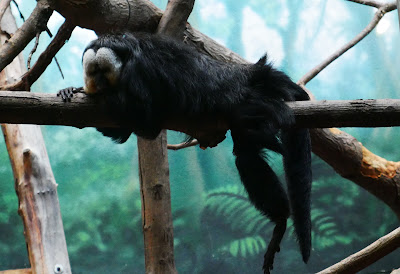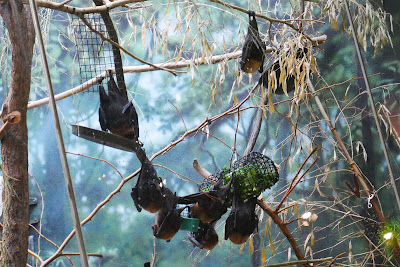It's been 7 years since last I visited the Philadelphia Zoo. Good Zoos are not static, and the Philadelphia Zoo is aligned with this ethos. The things that were down/reduced from my last visit to now, out-numbered the aspects that were up and vibrant. I wonder if this is part of a larger transition. There was no indication of this--hopeful thinking on my part, maybe. For example, in the center of the zoo was a Beer Garden/Restaurant that is gone completely for a little maze of trails through tall grass and weeds. Going to the far end of the zoo was a waste of time: no Maned Wolves, no Black-and-White Colobus Monkeys, the Cheetahs that are the next to last draw were not out, so you're down to a pair of Bald Eagles. Meanwhile habitats and a huge three-story tall habitat/observational tower are shuddered and dormant.
The first major encounter is a building built in 2010 and opened to the public in 2011: The Rare Animal Conserva- tion Center. The reason I know this is because it was still being "finished" in April of that year when I made my first visit to the Philadelphia Zoo. It faces a beautiful fountain and Impala Plaza with tables and chairs on the opposite side of the fountain were you can enjoy the fare from a small concession located in the center facing outward toward the plaza.
Inside you have a series of habitats all but one (the Naked Mole-rats) along the back wall that rise up at least 20 feet. They are home to a trio of species of monkey, (Francois' Langurs, White-faced Saki's, and Bolivian Grey Titi's) lesser primates (Both Golden Lion Tamarinds and Pied Tamarinds, and Geoffrey's Marmoset), Blue-eyed Black Lemurs, Hoffmann's Two-toed Sloths, a couple of small ground mammals (Black-and-Rufous Elephant Shrew and Blind Mole-rats), and an active band of Rodrigues Fruit Bats.
Also on display in the building were different eco-conservation-based art projects created by students who participated in educational programs at the Philadelphia Zoo such as these masks created by the Delphi After School Art Club.
Conservation Status: Least Concerned
WHITE-FACED SAKI MONKEY
Pithecia pithecia
Conservation Status: Least Concerned
A White-faced Saki chilling.
Rhynchocyon petersi
Conservation Status: Least Concerned
Rodrigues Fruit Bat habitat.
RODRIGUES FRUIT BAT
Pteropus rodricensis
Conservation Status: Critically Endangered
Also on display in the building were different eco-conservation-based art projects created by students who participated in educational programs at the Philadelphia Zoo such as these masks created by the Delphi After School Art Club.
All in all the Center is a beautiful facility and an excellent way to begin a visit. You get to see a lot of animals fairly up-close and unobstructed. The Maryland Zoo in Baltimore has a similar facility in its long-range master plan, and I've enjoyed the concept realized at the Henry Doorly Zoo in Omaha.












No comments:
Post a Comment